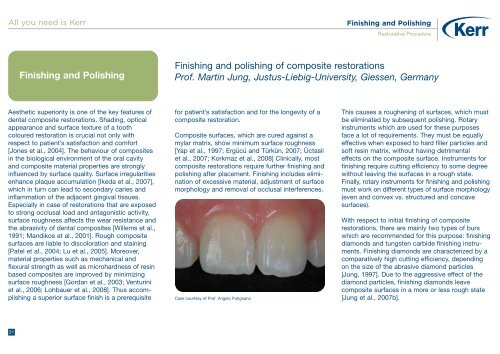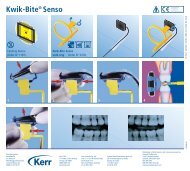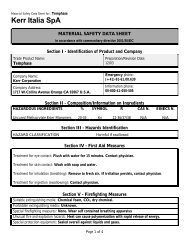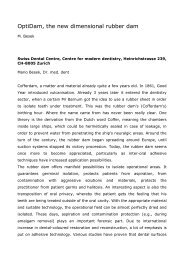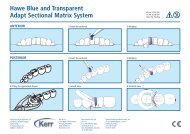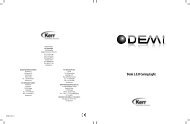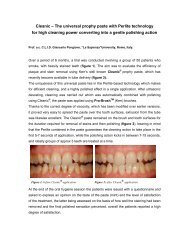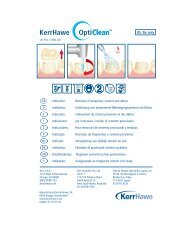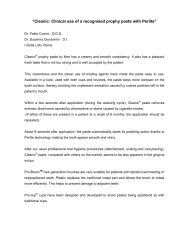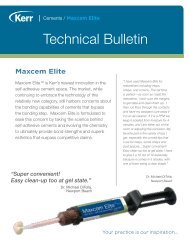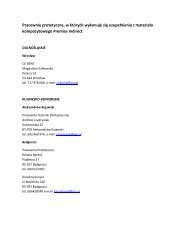Restorative Procedure - Kerr Hawe
Restorative Procedure - Kerr Hawe
Restorative Procedure - Kerr Hawe
Create successful ePaper yourself
Turn your PDF publications into a flip-book with our unique Google optimized e-Paper software.
All you need is <strong>Kerr</strong><br />
Finishing and Polishing<br />
<strong>Restorative</strong> <strong>Procedure</strong><br />
Finishing and Polishing<br />
Finishing and polishing of composite restorations<br />
Prof. Martin Jung, Justus-Liebig-University, Giessen, Germany<br />
Aesthetic superiority is one of the key features of<br />
dental composite restorations. Shading, optical<br />
appearance and surface texture of a tooth<br />
coloured restoration is crucial not only with<br />
respect to patient’s satisfaction and comfort<br />
[Jones et al., 2004]. The behaviour of composites<br />
in the biological environment of the oral cavity<br />
and composite material properties are strongly<br />
influenced by surface quality. Surface irregularities<br />
enhance plaque accumulation [Ikeda et al., 2007],<br />
which in turn can lead to secondary caries and<br />
inflammation of the adjacent gingival tissues.<br />
Especially in case of restorations that are exposed<br />
to strong occlusal load and antagonistic activity,<br />
surface roughness affects the wear resistance and<br />
the abrasivity of dental composites [Willems et al.,<br />
1991; Mandikos et al., 2001]. Rough composite<br />
surfaces are liable to discoloration and staining<br />
[Patel et al., 2004; Lu et al., 2005]. Moreover,<br />
material properties such as mechanical and<br />
flexural strength as well as microhardness of resin<br />
based composites are improved by minimizing<br />
surface roughness [Gordan et al., 2003; Venturini<br />
et al., 2006; Lohbauer et al., 2008]. Thus accomplishing<br />
a superior surface finish is a prerequisite<br />
for patient’s satisfaction and for the longevity of a<br />
composite restoration.<br />
Composite surfaces, which are cured against a<br />
mylar matrix, show minimum surface roughness<br />
[Yap et al., 1997; Ergücü and Türkün, 2007; Üctasli<br />
et al., 2007; Korkmaz et al., 2008] Clinically, most<br />
composite restorations require further finishing and<br />
polishing after placement. Finishing includes elimination<br />
of excessive material, adjustment of surface<br />
morphology and removal of occlusal interferences.<br />
Case courtesy of Prof. Angelo Putignano<br />
This causes a roughening of surfaces, which must<br />
be eliminated by subsequent polishing. Rotary<br />
instruments which are used for these purposes<br />
face a lot of requirements. They must be equally<br />
effective when exposed to hard filler particles and<br />
soft resin matrix, without having detrimental<br />
effects on the composite surface. Instruments for<br />
finishing require cutting efficiency to some degree<br />
without leaving the surfaces in a rough state.<br />
Finally, rotary instruments for finishing and polishing<br />
must work on different types of surface morphology<br />
(even and convex vs. structured and concave<br />
surfaces).<br />
With respect to initial finishing of composite<br />
restorations, there are mainly two types of burs<br />
which are recommended for this purpose: finishing<br />
diamonds and tungsten carbide finishing instruments.<br />
Finishing diamonds are characterized by a<br />
comparatively high cutting efficiency, depending<br />
on the size of the abrasive diamond particles<br />
[Jung, 1997]. Due to the aggressive effect of the<br />
diamond particles, finishing diamonds leave<br />
composite surfaces in a more or less rough state<br />
[Jung et al., 2007b].<br />
31


